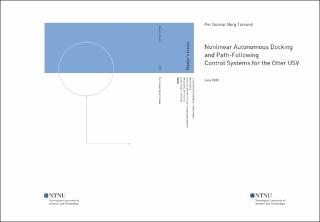| dc.description.abstract | Denne oppgaven gikk ut på å bruke ulineære kontrollalgoritmer for autonom dokking, banefølging og hinderunngåelse for Maritime Robotics sin minste overflatefarkost, "Oteren". Autonom dokking er for tiden et hett tema der flere løsninger har blitt presentert for fullaktuerte skip. "Oteren" blir bare kontrollert av to faste propeller/thrustere plassert akter, noe som gjør fartøyet underaktuert. Dette gjør kontrollproblemet mer utfordrende siden fartøyet ikke kan direkte beveges sidelengs (ved bruk av thrusterene). For å adressere dette ble det utviklet en simulator i Matlab der forskjellige kontrollordninger kunne testes der den ulineære dynamikken var modellert basert på data funnet i tidligere eksperimenter.
Oppgaven fokuserte på å implementere to høyere ordens Sliding Mode kontrollere (SMC) som kurskontrollere og å bruke en PI-kontroller som en fartskontroller. SMC-ene som ble implementert var en PID-SMC og en Super-Twisting kontroller (STC). Disse kontrollerne ble valgt ettersom de er robuste for parameterusikkerheter. I tillegg til disse ble en enkel PID-kurskontroller implementert og sammenlignet med SMC-ene. Disse kontrollerne ble brukt sammen med en Line of Sight (LOS) veiledningslov og en algoritme for hinderunngåelse til å beregne ønsket kurs for banefølging uten å kollidere med hinder. Fartøyet gikk inn i en dokkingsfase da det var innenfor en gitt avstand fra kaien der hastigheten til fartøyed ble redusert fra 1 m/s til 0.2 m/s.
For å sammenligne kontrollene med hverandre ble det utført en Monte-Carlo-simulering med 10000 iterasjoner. Strømhastigheten, strømvinkelen og hindringene ble generert stokastisk for hver iterasjon. Resultatet inneholder også to konstruerte tilfeller: en med svake havstrømmer og en med sterke havstrømmer. Disse tilfellene ble inkludert for å vise hvordan USVen hånderte både "milde" og "ekstreme" forhold. Monte-Carlo-simuleringen viste at STCen hadde lavest kurs- og kryssporingsfeil, og at PID-kontrolleren hadde dårligst ytelse. Den totale medianen av kryssporings- og kursfeilen for PID-SMCen var henholdsvis 114% og 66% større enn for STCen. Videre var energiforbruket til STCen litt lavere enn de andre kontrollerne, men siden det var veldig lite forskjell i energiforbrukmellom kontrollerne ble dette sett på som trivielt.
Det foreslås at hastighetskontrolleren kan forbedres ved å bruke en mer avansert kontroller som for eksempel STC. For enda mer realistiske simuleringer, anbefales det at andre ytre forstyrrelser som vind og bølger inkluderes. Til slutt anbefales det å teste kontrollerne på den faktiske "Oteren". | |
| dc.description.abstract | This thesis aimed to use nonlinear control algorithms for autonomous docking, path following and obstacle avoidance for Maritime Robotics smallest Unmanned Surface Vessel (USV), the Otter USV. The field of autonomous docking is currently a popular topic where multiple solutions have been presented for fully actuated vessels. However, the Otter USV is only controlled by two fixed rear thrusters, making the vessel underactuated. The fact that the thrusters are fixed means that they are unable to directly affect the sideways motion of the vessel, which complicates the control problem. In order to address this problem, a simulator was developed in Matlab where the nonlinear dynamics of the Otter USV were based on data from previous experiments. The simulator was developed in order to test various control schemes on the Otter USV.
In this thesis, a PID controller and two higher order Sliding Mode Controllers (SMCs) were implemented as course controllers and a PI controller as a surge controller. The SMCs that were implemented was a PID-SMC and a Super-Twisting Controller (STC). These controllers were chosen since they are robust to parameter uncertainties. The PID controller was implemented to compare the SMCs with a "simple" controller. These controllers were used together with a Line of Sight (LOS) guidance law and a obstacle avoidance algorithm in order to calculate the desired course for path following while avoiding obstacles. The vessel entered a docking phase when it was within a given distance from the dock. This phase consisted of reducing the surge speed from 1 to 0.2 m/s.
In order to compare the controllers to each other, a Monte-Carlo simulation of 10000 iterations was conducted. The current velocity, crab angle and obstacles was stochastically generated for each iteration. The results also consists of two constructed cases: one with weak ocean currents and one with strong ocean currents. These cases were included in order to show how the USV handled both "mild" and "extreme" conditions. The Monte-Carlo simulation showed that the STC tracked the course and had the lowest cross-track error out of all controllers, while the PID controller had the worst performance. The total median course and cross-track error for the PID-SMC was 114% and 66% larger than for the STC, respectively. Furthermore, the energy consumption of the STC was slightly lower than the other controllers. However, since there was very little difference in energy consumption between the controllers, this was seen as trivial.
It's suggested that the surge controller can be improved by using more a advance controller such as the STC. For even more realistic simulations, it's recommended that other external disturbances such as wind and waves are included. Lastly, it's recommended to test the controllers by implementing them on the actual Otter USV. | |
